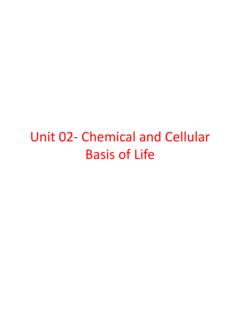Transcription of IOMOLECULES
1 142 BIOLOGYT here is a wide diversity in living organisms in our biosphere. Now aquestion that arises in our minds is: Are all living organisms made of thesame chemicals, , elements and compounds? You have learnt inchemistry how elemental analysis is performed. If we perform such ananalysis on a plant tissue, animal tissue or a microbial paste, we obtain alist of elements like carbon, hydrogen, oxygen and several others andtheir respective content per unit mass of a living tissue. If the same analysisis performed on a piece of earth s crust as an example of non-living matter,we obtain a similar list. What are the differences between the two lists? Inabsolute terms, no such differences could be made out. All the elementspresent in a sample of earth s crust are also present in a sample of livingtissue.
2 However, a closer examination reveals that the relative abundanceof carbon and hydrogen with respect to other elements is higher in anyliving organism than in earth s crust (Table ). TO ANALYSE CHEMICAL COMPOSITION?We can continue asking in the same way, what type of organic compoundsare found in living organisms? How does one go about finding the answer?To get an answer, one has to perform a chemical analysis. We can take anyliving tissue (a vegetable or a piece of liver, etc.) and grind it in trichloroaceticacid (Cl3 CCOOH) using a mortar and a pestle. We obtain a thick slurry. Ifwe were to strain this through a cheesecloth or cotton we would obtain twofractions. One is called the filtrate or more technically, the acid-solublepool, and the second, the retentate or the acid-insoluble fraction.
3 Scientistshave found thousands of organic compounds in the acid-soluble to AnalyseChemicalComposition? of BondLinking Monomersin a State ofBody Constituents- Concept Basis Living (19/01/2015)BIOMOLECULES143In higher classes you will learn about howto analyse a living tissue sample and identify aparticular organic compound. It will suffice tosay here that one extracts the compounds, thensubjects the extract to various separationtechniques till one has separated a compoundfrom all other compounds. In other words, oneisolates and purifies a compound. Analyticaltechniques, when applied to the compound giveus an idea of the molecular formula and theprobable structure of the compound. All thecarbon compounds that we get from livingtissues can be called biomolecules.
4 However,living organisms have also got inorganicelements and compounds in them. How do weknow this? A slightly different but destructiveexperiment has to be done. One weighs a smallamount of a living tissue (say a leaf or liver andthis is called wet weight) and dry it. All the water,evaporates. The remaining material gives dryweight. Now if the tissue is fully burnt, all thecarbon compounds are oxidised to gaseousform (CO2, water vapour) and are removed. Whatis remaining is called ash . This ash containsinorganic elements (like calcium, magnesiumetc). Inorganic compounds like sulphate,phosphate, etc., are also seen in the acid-solublefraction. Therefore elemental analysis giveselemental composition of living tissues in theform of hydrogen, oxygen, chlorine, carbon analysis for compounds gives an idea ofElement% Weight of Earth s crust Human bodyHydrogen (H) (C) (O) (N)very (S) (Na) (Ca) (Mg) (Si) * Adapted from CNR Rao, Understanding Chemistry,Universities Press, Comparison of Elements Presentin Non-living and Living Matter*ComponentFormulaSodiumNa+Potassiu mK+CalciumCa++MagnesiumMg++WaterH2 OCompoundsNaCl, CaCO3,POSO4342 ,TABLE List of Representative InorganicConstituents of Living Tissuesthe kind of organic (Figure ) and inorganic constituents (Table )present in living tissues.
5 From a chemistry point of view, one can identifyfunctional groups like aldehydes, ketones, aromatic compounds, etc. Butfrom a biological point of view, we shall classify them into amino acids,nucleotide bases, fatty acids acids are organic compounds containing an amino group andan acidic group as substituents on the same carbon , the , they are called -amino acids. They are substituted methanes. Thereare four substituent groups occupying the four valency positions. Theseare hydrogen, carboxyl group, amino group and a variable groupdesignated as R group. Based on the nature of R group there are manyamino acids. However, those which occur in proteins are only of twenty2015-16(19/01/2015)144 BIOLOGY types. The R group in these proteinaceous amino acids could be a hydrogen(the amino acid is called glycine), a methyl group (alanine), hydroxy methyl(serine), etc.
6 Three of the twenty are shown in Figure chemical and physical properties of amino acids are essentiallyof the amino, carboxyl and the R functional groups. Based on number ofamino and carboxyl groups, there are acidic ( , glutamic acid), basic(lysine) and neutral (valine) amino acids. Similarly, there are aromaticamino acids (tyrosine, phenylalanine, tryptophan). A particular propertyof amino acids is the ionizable nature of NH2 and COOH groups. Hencein solutions of different pHs, the structure of amino acids is called zwitterionic are generally water insoluble. They could be simple fatty fatty acid has a carboxyl group attached to an R group. The R groupcould be a methyl ( CH3), or ethyl ( C2H5) or higher number of CH2groups (1 carbon to 19 carbons).
7 For example, palmitic acid has 16carbons including carboxyl carbon. Arachidonic acid has 20 carbonatoms including the carboxyl carbon. Fatty acids could be saturated(without double bond) or unsaturated (with one or more C=C doublebonds). Another simple lipid is glycerol which is trihydroxy propane. Manylipids have both glycerol and fatty acids. Here the fatty acids are foundesterified with glycerol. They can be then monoglycerides, diglyceridesand triglycerides. These are also called fats and oils based on meltingpoint. Oils have lower melting point ( , gingely oil) and hence remain asoil in winters. Can you identify a fat from the market? Some lipids havephosphorous and a phosphorylated organic compound in them.
8 Theseare phospholipids. They are found in cell membrane. Lecithin is oneexample. Some tissues especially the neural tissues have lipids with morecomplex organisms have a number of carbon compounds in whichheterocyclic rings can be found. Some of these are nitrogen bases adenine, guanine, cytosine, uracil, and thymine. When found attached toa sugar, they are called nucleosides. If a phosphate group is also foundesterified to the sugar they are called nucleotides. Adenosine, guanosine,thymidine, uridine and cytidine are nucleosides. Adenylic acid, thymidylicacid, guanylic acid, uridylic acid and cytidylic acid are nucleotides. Nucleicacids like DNA and RNA consist of nucleotides only. DNA and RNA functionas genetic (19/01/2015)BIOMOLECULES145 HOCholesterolPhospholipid (Lecithin)Fats and oils (lipids)(CH )2 14CH3 COOHF atty acid(Palmitic acid)GlycerolTriglyceride (R1, R2and R3 are fatty acids)Nitrogen basesOHOHA denineOOCH2 PHOOHOA denylic acidNucleotideOHOHHOCH2 AdenineOOHOHHOCH2 UracilOAdenosineUridineNucleosidesOHOHOH HOCH2 OOHOHHOOHCH OH2OC6H12O6 (Glucose)C5H10O5 (Ribose)Sugars (Carbohydrates)SerineGlycineAmino acidsAlanineFigure representation of small molecular weight organiccompounds in living tissuesOOHNNHA denine (Purine)Uracil (Pyrimidine)2015-16(19/01/2015)
9 AND SECONDARY METABOLITESThe most exciting aspect of chemistry deals with isolating thousands ofcompounds, small and big, from living organisms, determining theirstructure and if possible synthesising one were to make a list of biomolecules, such a list would havethousands of organic compounds including amino acids, sugars, reasons that are given in section , we can call these biomoleculesas metabolites . In animal tissues, one notices the presence of all suchcategories of compounds shown in Figure These are called primarymetabolites. However, when one analyses plant, fungal and microbial cells,one would see thousands of compounds other than these called primarymetabolites, alkaloids, flavonoids, rubber, essential oils, antibiotics,coloured pigments, scents, gums, spices.
10 Theseare called secondary metabolites (Table ).While primary metabolites have identifiablefunctions and play known roles in normalphysiologial processes, we do not at the moment,understand the role or functions of all the secondary metabolites in host , many of them are useful to humanwelfare ( , rubber, drugs, spices, scents andpigments). Some secondary metabolites haveecological importance. In the later chapters andyears you will learn more about is one feature common to all those compounds found in the acidsoluble pool. They have molecular weights ranging from 18 to around800 daltons (Da) acid insoluble fraction, has only four types of organic , proteins, nucleic acids, polysaccharides and lipids.













